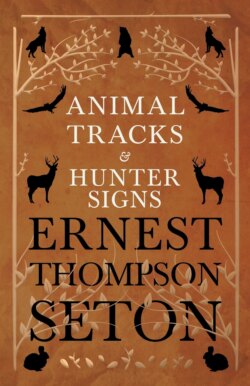Читать книгу Animal Tracks and Hunter Signs - Ernest Thompson Seton - Страница 12
На сайте Литреса книга снята с продажи.
1 The Oldest of All Writing
Оглавление“I wish I could go West and join the Indians so that I should have no lessons to learn,” said an unhappy small boy who could discover no atom of sense or purpose in any one of the three Rs.
“You never made a greater mistake,” replied the scribe, “for the young Indian has many lessons to learn from his earliest days—hard lessons and hard punishments.
“With him the dread penalty of failure is ‘go hungry till you win’; and no more important task has he than his reading lesson.
“Not just twenty-six characters are to be learned in this exercise, but a thousand. Not clear straight print are these characters, but dim, washed-out, crooked traces. Not indoors on comfortable chairs are the lessons, with a wise and patient teacher always near, but out in the forest, often alone, and in every kind of weather.
“There he slowly deciphers the letters and reads sentences of the oldest writing on earth—a style so old that the hieroglyphs of Egypt, the cylinders of Nippur, and the drawings of the cave men are as things of today in comparison; a writing indeed that is older than mankind, the one universal script. I mean the tracks in the dust, the mud, or the snow.
“These are the inscriptions that every hunter, Red or White, must learn to read infallibly. And, be the writing strong or faint, straight or crooked, simple or overwritten with many a puzzling diverse phrase, he must decipher and follow swiftly, unerringly, if there is to be a successful ending to the hunt which provides his daily food.”
This is the reading lesson of the young Indian, and it is a style that will never become superseded.
The naturalist also must acquire some measure of proficiency in the ancient art. Its usefulness is perennial to the student of wildlife; without it he would know little of the people of the wood.
It is a remarkable fact that there are always more wild animals about than any but the expert has any idea of. For example there are, within twenty miles of New York City, fully fifty different kinds, not counting birds, reptiles, or fishes, at least one quarter of which are abundant. Or, more particularly, within the limits of Greater New York, living their free and normal lives, there are at least a dozen species of wild beasts, half of which are quite common.
To illustrate: along the shores of Staten Island and Long Island one will surely find Mink, Muskrat, and Coon, not to mention Bats. In the woods will be Gray Squirrels, Red Squirrels, Flying Squirrels, Chipmunks, Moles, and Shrews. Around the farms and other homes, House Rats, House Mice, and Deer Mice would abound. Possums, Woodchucks, Skunks, and Weasels are occasional, and a number of others make their appearance here and there.
“Then how is it that we never see any?” is the first question of the incredulous. The answer is simple.
Tracks near the barn
Long ago the beasts learned this dire lesson: Man is your worst enemy; shun him at any price. And the simplest way to do this is to come out only at night. Man is a daytime creature; he is blind in the soft half-light or darkness that most beasts prefer.
While many animals have always limited their activity to the hours of twilight and gloom, there are not a few that were once diurnal, but have given up that portion of their working day in order to avoid the archenemy, man.
Thus they can flourish under our noses, and eat at our tables, without our consent or even knowledge. They come and go at will, and the world knows nothing of them. Their presence might long be unsuspected, but for one thing, well known to the hunter, the trapper, and the naturalist. WHEREVER THE WILD FOURFOOT GOES, IT LEAVES BEHIND IT A DETAILED RECORD OF ITS VISIT. This it puts down in the ancient script of the woods, the script of the footmark trail, the story of at least a portion of its life.
Each of these dotted lines is a wonderful record of the creature’s activity during the time it was there. It needs only the patient work of the seeker to decipher that record and from it learn much about the animal that made it; yes, even without that animal ever having been seen by him.
Savages are more skilled in this art than are civilized folk, for tracking is their serious lifelong pursuit, and they have not injured their eyes with books. Intelligence is, indeed, important here as elsewhere; yet it is a remarkable fact that the lowest race of mankind, the Australian blacks, are reputed to be by far the best trackers. Not only are their eyes and attention developed and disciplined, but they have retained much of the scent power that civilized man has lost. They can follow a fresh track, partly at least, by smell.
Woodland and marsh life
